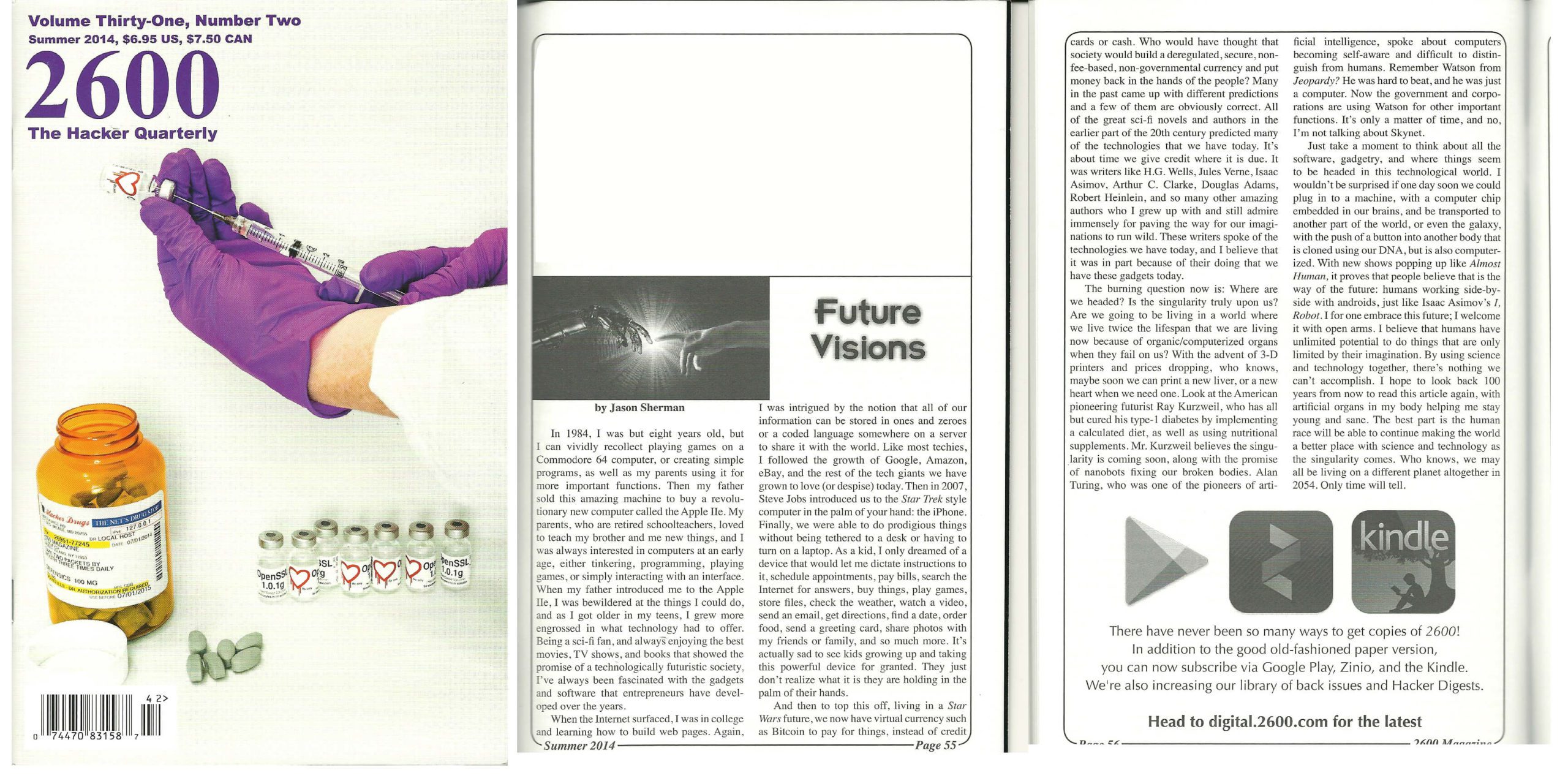Future Visions – 1984

This article was published in the Summer 2014 edition of The Hacker Quarterly – 2600
In 1984, I was but eight years old, but I can vividly recollect playing games on a Commodore 64 computer, or creating simple programs, as well as my parents using it for more important functions. Then my father sold this amazing machine to buy a revolutionary new computer called the Apple IIe. My parents, who are retired schoolteachers, loved to teach my brother and I new things, and I was always interested in computers at an early age, either tinkering, programming, playing game’s, or simply interacting with an interface. When my father introduced me to the Apple IIe, I was bewildered at the things I could do, and as I got older in my teens, I grew more engrossed in what technology had to offer. Being a Sci-fi fan, and always enjoying the best movies, TV shows and books that showed the promise of a technologically futuristic society, I’ve always been fascinated with the gadgets and software that entrepreneurs have developed over the years.
When the Internet surfaced, I was in college and learning how to build web pages, again I was intrigued by the notion that all of our information can be stored in 1s and 0s or a coded language somewhere on a server to share it with the world. Like most techies, I followed the growth of Google, Amazon, eBay, and the rest of the tech giants we have grown to love (or despise) today. Then in 2007, Steve Jobs introduced us to the Star Trek style computer in the palm of your hand: the iPhone. Finally we were able to do prodigious things without being tethered to a desk or having to turn on a laptop. As a kid, I only dreamed of a device that would let me dictate instructions to it, schedule appointments, pay bills, search the Internet for answers, buy things, play games, store files, check the weather, watch a video, send an email, get directions, find a date, order food, send a greeting card, share photos with my friends or family and so much more. It’s actually sad to see kids growing up and taking this powerful device for granted. They just don’t realize what it is they are holding in the palm of their hands.
And then to top this off, living in a Star Wars future, we now have virtual currency such as Bitcoin to pay for things, instead of credit cards or cash. Who would have thought that society would build a deregulated, secure, non-fee-based, nongovernmental currency and put money back in the hands of the people. Many people in the past came up with different predictions and a few of them are obviously correct. All of the great Sci-fi novels and authors in the earlier part of the 20th century predicted many of the technologies that we have today. It’s about time we give credit where it is due. It was writers like H.G. Wells, Jules Verne, Isaac Asimov, Arthur C. Clarke, Douglas Adams, Robert Heinlein and so many other amazing authors who I grew up with and still admire immensely for paving the way for our imaginations to run wild. These writers spoke of the technologies we have today, and I believe that it was in part their doing that we have these gadgets today.
The burning question now is: Where are we headed? Is the Singularity truly upon us? Are we going to be living in a world where we live twice the lifespan that we are living now because of organic/computerized organs when they fail on us? With the advent of 3-D printers and prices dropping, who knows, maybe soon we can print a new liver, or a new heart when we need one. Look at the American pioneering, futurist Ray Kurzweil who has all but cured his type-1 diabetes by implementing a calculated diet, as well as using nutritional supplements. Mr. Kurzweil believes the Singularity is coming soon, along with the promise of Nanobots fixing our broken bodies. Alan Turing, who was one of the pioneers of artificial intelligence spoke about computers becoming self-aware and difficult to distinguish from humans. Remember Watson from Jeopardy? He was hard to beat, and he was just a computer. Now the government and corporations are using Watson for other important functions. It’s only a matter of time, and no I’m not talking about Skynet.
Just take a moment to think about all the gadgetry, software, and where things seem to be headed in this technological world. I wouldn’t be surprised if one day soon we could plug into a machine, with a computer chip embedded in our brains, and transport ourselves to another part of the world or even the galaxy with the push of a button into another body that is cloned using our DNA, but is also computerized. With new shows popping up like Almost Human, it proves that people believe that is the way of the future, humans working side-by-side with androids, just like Isaac Asimov’s “I Robot”. I for one embrace this future, I welcome it with open arms. I believe that humans have unlimited potential to do things that are only limited by their imagination. By using science and technology together, there’s nothing we can’t accomplish. I hope to look back 100 years from now to read this article again, with artificial organs in my body helping me stay young and sane. The best part is the human race will be able to continue making the world a better place with science and technology as the Singularity comes. Who knows, we may all be living on a different planet all together in 2054. Only time will tell.
![]()





